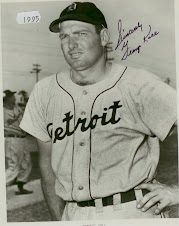

This week’s ballot is pretty short, only three candidates, and (IMHO) a slam dunk for one guy, Ty Cobb.
I don’t think anybody liked him, but everybody admits, he must have been one of the greatest. In 1911 he walked on water, at the plate and in the field. Has his average, .420, been matched in the last century? I don’t think so. Granted, it was a different game back then, and two very different leagues. Honus Wagner led the National League with .334, but “Shoeless” Joe hit .408, and Cobb’s teammate Sam Crawford hit .378 in the “Junior Circuit” (been a long time since I’ve seen a sportswriter use that term.) ironically, there seems to be some good pitching in those days, with two guys coming in with ERA’s under two, and at least five 20 game-winners. As I said, must have been a different game, but I digress from Cobb’s great year.
He led the league in RBI’s, total bases, slugging average, stolen bases, runs scored, doubles, triples and second in homers. Getting a hit almost every other time he went to the plate, you would think pitchers would have walked him intentionally more often, but he didn’t rank in the top three in walks.
Almost as amazing is his fielding. He led the league total fielding chances per game and put-outs for a center fielder, and took part in an amazing and league leading 10 double plays! (Must have had a gun for an arm.)
Take points off his score for being a totally miserable teammate, and see if you think he was the best.
Amazingly, even though the Tigers had Cobb and Crawford, and a slick-fielding shortstop named Bush who led the league in many defensive categories, they came in second to Connie Mack’s Athletics.
 Can you imagine how tough it must have been to replace Cobb, with Cobb watching over you, and sharing the position abut a third of the time? That was the fate of Heine Manush, who hit .378 and took the AL crown for batting average in 1926. While we must give him his due, the hitters seemed to be in power in this era, with Manush, and five others hitting better than .350.
Can you imagine how tough it must have been to replace Cobb, with Cobb watching over you, and sharing the position abut a third of the time? That was the fate of Heine Manush, who hit .378 and took the AL crown for batting average in 1926. While we must give him his due, the hitters seemed to be in power in this era, with Manush, and five others hitting better than .350.For whatever reason, the Tigers traded him before the 1928 season, and slid to a losing record that year in sixth place.
We all love Curtis Granderson and what he did for the Tigers in 2007, reaching the 20-20-20 club, and hitting .302 with power. His range in the field is awesome. To his credit, he is a great teammate, with speed and contributed to a pennant winner. To his detriment, he did strike out a lot, and if we are measuring these guys by the “best in the league” in the same year, Curtis was overshadowed by teammate Mags by 60 points in average.
I dare say his best years (maybe an MVP) are still ahead of him) but does this season match Cobb in 1911?























Having a little trouble with the photo editor today guys. Maybe later this week! Go ahead and vote.
ReplyDeleteWhat? No mention of Ron LeFlore???!!!! :)
ReplyDeleteYou're right! And this is one commissioner that doesn't mind admitting he was wrong. To give him his due, in 1978 LeFlore hit .297 in 155 games, led the league in stolen bases and runs scored and put outs for a center fielder. Not bad, but only 12 HRs, and 35 points behind Rod Carew who got the batting title that year. Cobb still gets my vote.
ReplyDeleteAnd LeFlore had a book and movie about him: "One in a Million." Levar Burton played LeFLore in the movie. Billy Martin made a cameo. I was at Tiger Stadium when they filmed some crowd shots and action scenes before a game.
ReplyDeleteAnd Cobb had a movie and at least two books written about him! (One an autobiography if I recall, and one by the infamous Mr. Stubb, upon which the movie took its basis and a main character.
ReplyDelete